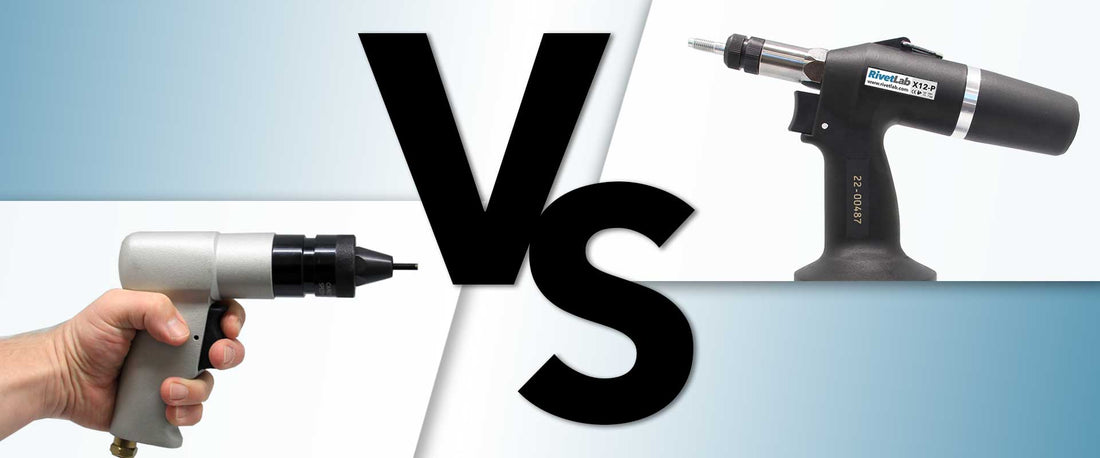Installing rivet nuts efficiently and accurately is crucial in many manufacturing and production processes. These fasteners enable strong, reliable threaded attachments in a range of materials — from sheet metal to composite panels. Rivet nut tools come in manual, cordless, or air-powered varieties, and even within air-powered rivet nut tools, there are two main types: spin-pull and spin-spin. While both serve the same purpose of securing rivet nuts, they work in different ways, offering unique advantages depending on your application.
In this blog, we will dive into the differences between spin-pull and spin-spin air rivet nut tools – how they work and when each is the best choice.
Spin-Pull Rivet Nut Tools
Spin-pull rivet nut tools (also known as spin-pull-spin tools) are powered tools — typically pneumatic or cordless electric — designed for high-volume production settings.
They work in a three-step process:
-
Spin-On (Threading the Rivet Nut)
The tool rotates its mandrel clockwise to thread it into the rivet nut, ensuring a secure grip. -
Pull Stroke (Collapse the Rivet Nut)
The tool pulls back the mandrel without turning, collapsing or deforming the unthreaded portion of the rivet nut to create a firm grip against the rear side of the material. -
Spin-Off (Release)
The tool reverses direction and spins the mandrel counter-clockwise to detach it, leaving a firmly installed rivet nut in place.
Spin-pull tools come with several key features that make them a preferred choice for high-volume production. They’re fast and efficient, allowing for quick and consistent installation of rivet nuts. These tools also provide precise control, with adjustable pulling force and stroke to accommodate different rivet nut sizes and material thicknesses. Built to be durable and reliable, spin-pull tools are designed for repeated heavy-duty use in industrial environments, ensuring long-lasting performance.
Spin-Spin Rivet Nut Tools
Spin-spin rivet nut tools work slightly differently from spin-pull tools. They’re typically used for applications with a set torque and a single rivet nut size, offering a lower-cost, more straightforward solution, often powered by a pneumatic or electric motor.
The setting process is as follows:
-
Spin-On (Thread the Mandrel)
The tool rotates the mandrel clockwise to thread it into the rivet nut. -
Spinning Collapse
Instead of pulling back, the tool continues spinning while applying pressure against a stop or a clutch. This causes the rivet nut’s body to deform and grip the rear side of the material. -
Spin-Off (Release)
The tool then reverses direction, spinning counterclockwise to detach from the installed rivet nut.
Key Differences Between Spin-Pull and Spin-Spin Tools
| Feature | Spin-Spin Tool | Spin-Pull Tool |
| Collapse Method | Torque-based spinning | Linear pulling stroke |
| Precision | Less precise (torque-controlled) | Very precise (stroke/pressure-controlled) |
| Working Capacity | Usually single-sized | Works with a range of rivet nut sizes |
| Material-wise | Steel rivet nuts | Steel, aluminium, or stainless steel rivet nuts |
| Tool Complexity | Simpler and cheaper | More advanced and programmable |
Spin-spin tools are an excellent choice for installing rivet nuts into plastic, thin aluminium, or soft sheet metal, especially when working with high volumes of a single size and looking for a cost-effective solution, and when precise control over stroke isn’t a priority. However, there are some limitations to be aware of: over-spinning or thread damage can occur if the torque isn’t calibrated correctly, and these tools are unsuitable for aluminium or stainless steel rivet nuts due to their tendency toward galling* under pressure.
In comparison, spin-pull tools have more control over stroke or pressure adjustment, making them adaptable to a wide range of rivet nut sizes and materials.
The air rivet nut tools that RivetLab provides are primarily spin-pull tools, including the Gesipa® Firefox 2F, FAR KJ45S, RivetLab X12-P, and the RivetLab RL-100 – the tool on the market designed to handle M16 rivet nuts. In contrast, the RivetLab TA-800 series are spin-spin air rivet nut guns, designed exclusively for installing steel rivet nuts.
We can also supply spin-spin tools on demand. Just call our sales team on 02 9882 1112 and let us know your application, and we’ll be able to recommend the most suitable tool for your needs.
* What is galling?
Galling refers to a form of cold welding or adhesive wear that occurs when two metal surfaces slide against each other under pressure, typically under high friction with poor or no lubrication.
This phenomenon is especially prone to happen with spin-spin tools when installing rivet nuts made of stainless steel or aluminium. As the mandrel’s threaded rod and the rivet nut’s internal threads come into close, high-frictional contact, heat and pressure build up.
Stainless steel, particularly, is susceptible to galling due to its high surface energy and poor thermal conductivity, causing metal transfer or “welding” between the two surfaces. This can result in thread binding or seizing, making it difficult or even impossible to remove the mandrel after setting the rivet nut. It can also damage both the tool’s mandrel and the rivet nut’s internal threads, ultimately reducing the tool’s service life and affecting installation reliability.


